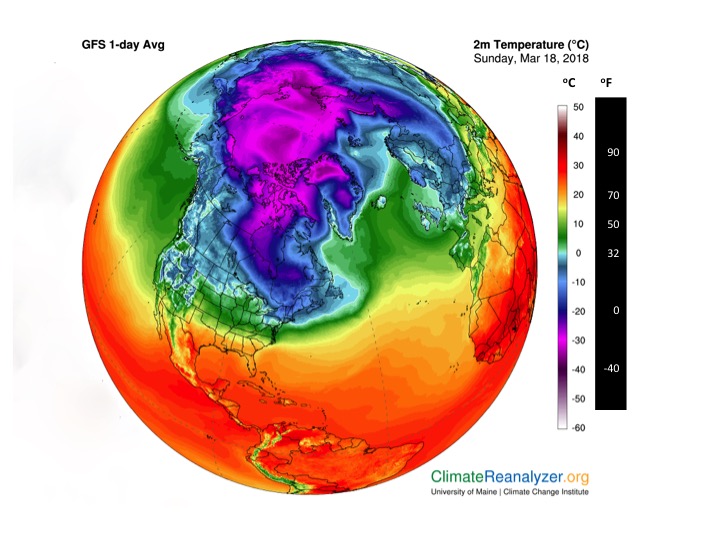More Snow in a Warming World
Riley, Quinn, and Skylar – the terrible trio of recent Nor’easter storms. Poor Boston and the larger region from the mid-Atlantic to New England. They have had record amounts of snow in the last few weeks. And as shown in the headline story on the Weather Channel, another one could even hit this coming week, perhaps even on the first day of Spring. What’s going on? If the planet is warming, why are we getting so much snow in some places? And it’s not just the U.S. France got a heavy snowfall this weekend too.
Though counterintuitive the explanation is simple. Snow requires two things, lots of moist air, and below freezing temperature.
Warmer oceans evaporate more, putting more moisture in the air. Global ocean temperatures are already more than one and a half degrees Fahrenheit (~one degree Celsius) warmer compared to a century ago and on track to get much warmer yet. Even if the world could find a way to meet the goals of the 2015 Paris Climate Agreement, that would mean another two degree Fahrenheit increase, putting much more moisture in the air in the coming years.
Excess moisture in the air must come down as rain or snow, of course to be determined by the prevailing temperature.
Temperature patterns are a bit more complicated, being somewhat regional and unpredictable. This graphic of temperatures today (March 18) is a good illustration, showing the areas of hot and cold, for half the world. And we should note that this week will mark the end of Winter and the start of Spring.
Although the world is getting ever-warmer on average, there are still large areas of freezing cold temperatures — large cold air masses, though they are shrinking in size compared to prior decades. And as warm air naturally pushes up towards the Arctic, that force can have the effect to push a large mass of cold air southward. When an area of moist air hits freezing temperatures, we get lots of snow as illustrated in the last few weeks. We can expect more of this in the years ahead, due to the increased evaporation, and the dislocated cold air masses.
Warmer oceans = more moisture = more rain or snow
To summarize, while we hopefully work hard to slow the warming as much as possible, we need to be prepared for the direct effects of a warmer ocean. Four effects are almost assured by basic physics:
- Warmer global average temperatures, including record heat and draught.
- More precipitation, both rain and snow.
- Rising sea level, as the ice on land melts.
- Strange weather patterns caused by the increased heat energy in the atmosphere and oceans.
Weather has always varied and always will. Climate is the longer term patterns and averages spanning decades. Scientifically the last 11,400 years were a relatively stable climate period known as the Holocene. Welcome to the future – also known as the Anthropocene, the climate era influenced by humans.


